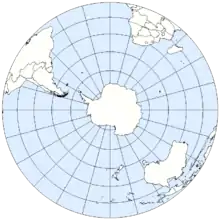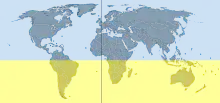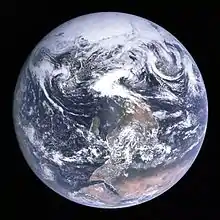Southern Hemisphere
The Southern Hemisphere is the half of Earth that is south of the Equator. It contains all or parts of five continents[1] (Antarctica, Australia, about 90% of South America, one third of Africa, and several islands off the continental mainland of Asia), four oceans (Indian, South Atlantic, Southern, and South Pacific), New Zealand and most of the Pacific Islands in Oceania. Its surface is 80.9% water, compared with 60.7% water in the case of the Northern Hemisphere, and it contains 32.7% of Earth's land.[2]


Owing to the tilt of Earth's rotation relative to the Sun and the ecliptic plane, summer is from December to February (inclusive) and winter is from June to August (inclusive). September 22 or 23 is the vernal equinox and March 20 or 21 is the autumnal equinox. The South Pole is in the center of the southern hemispherical region.
Characteristics
Southern Hemisphere climates tend to be slightly milder than those at similar latitudes in the Northern Hemisphere, except in the Antarctic which is colder than the Arctic. This is because the Southern Hemisphere has significantly more ocean and much less land; water heats up and cools down more slowly than land.[3] The differences are also attributed to oceanic heat transfer and differing extents of greenhouse trapping.[4]


In the Southern Hemisphere, the sun passes from east to west through the north, although north of the Tropic of Capricorn the mean sun can be directly overhead or due north at midday. The Sun follows a right-to-left trajectory through the northern sky unlike the left-to-right motion of the Sun when seen from the Northern Hemisphere as it passes through the southern sky. Sun-cast shadows turn anticlockwise throughout the day and sundials have the hours increasing in the anticlockwise direction. During solar eclipses viewed from a point to the south of the Tropic of Capricorn, the Moon moves from left to right on the disc of the Sun (see, for example, photos with timings of the solar eclipse of November 13, 2012), while viewed from a point to the north of the Tropic of Cancer (i.e., in the Northern Hemisphere), the Moon moves from right to left during solar eclipses.
The Coriolis effect causes cyclones and tropical storms to spin clockwise in the Southern Hemisphere (as opposed to anticlockwise in the Northern Hemisphere).[5]
The southern temperate zone, a subsection of the Southern Hemisphere, is nearly all oceanic.
The Sagittarius constellation that includes the galactic centre is a southern constellation as well as both Magellanic Clouds. This, combined with clearer skies, makes for excellent viewing of the night sky from the Southern Hemisphere with brighter and more numerous stars.
Forests in the Southern Hemisphere have special features which set them apart from those in the Northern Hemisphere. Both Chile and Australia share, for example, unique beech species or Nothofagus, and New Zealand has members of the closely related genera Lophozonia and Fuscospora. The eucalyptus is native to Australia but is now also planted in Southern Africa and Latin America for pulp production, and increasingly, biofuel uses.
Demographics and human geography

More than 800 million humans live in the Southern Hemisphere, representing around 10–12% of the total global human population of 7.3 billion.[6][7] Of those 800 million people, more than 200 million live in Brazil, the largest country by land area in the Southern Hemisphere, while 145 million live on the island of Java, the most populous in the world. The most populous country in the Southern Hemisphere is Indonesia, with 267 million people (roughly 30 million of whom live north of the Equator on the northern portions of the islands of Sumatra, Borneo, and Sulawesi, as well as the most of North Maluku, while the rest of the population lives in the Southern Hemisphere). Portuguese is the most spoken language in the Southern Hemisphere, with over 230 million speakers in eight countries.[8]
The largest metropolitan areas in the Southern Hemisphere are Jakarta (33 million people), São Paulo (22 million), Kinshasa-Brazzaville (17 million), Buenos Aires (16 million), Rio de Janeiro, Surabaya (12 million each), Johannesburg (11 million), Lima (10 million), Bandung (9 million), Luanda (8 million), Dar es Salaam (7 million), Santiago, Semarang (6 million each), Sydney, Belo Horizonte and Melbourne (5 million each). Important financial and commercial centers in the Southern Hemisphere include São Paulo, where the B3 (stock exchange) is headquartered, along with Sydney, home to the Australian Securities Exchange, Jakarta, seat of the Indonesia Stock Exchange, Johannesburg, home to the Johannesburg Stock Exchange, and Buenos Aires, headquarters of the Buenos Aires Stock Exchange, the oldest stock market in the Southern Hemisphere.
Among the most developed nations in the Southern Hemisphere is Australia, with a nominal GDP per capita of USD 51,885 and a Human Development Index (HDI) of 0.944, the eighth-highest in the world as of the 2020 report. New Zealand is also well developed, with a nominal GDP per capita of USD 38,675 and an HDI of 0.931, putting it at number 14 in the world in 2020. The least developed nations in the Southern Hemisphere cluster in Africa and Oceania, with Mozambique and Burundi at the lowest ends of the HDI, at 0.456 (number 181 in the world) and 0.433 (number 185 in the world), respectively. The nominal GDPs per capita of these two countries do not go above USD 550, a tiny fraction of the incomes enjoyed by Australians and New Zealanders.
The most widespread religions in the Southern Hemisphere are Christianity in South America, Southern Africa, Australia and Oceania, followed by Islam in most of the islands of Indonesia and in parts of southeastern Africa, and Hinduism, which is mostly concentrated on and around the islands of Bali, Mauritius and Lombok.
The oldest continuously inhabited city in the Southern Hemisphere is Bogor, in western Java, which was founded in 669 CE. Ancient texts from the Hindu kingdoms prevalent in the area definitively record 669 CE as the year when Bogor was founded. However, some evidence shows that Zanzibar, an ancient port with around 200,000 inhabitants off the coast of Tanzania, may be older than Bogor. A Greco-Roman text written between 1 and 100 CE, the Periplus of the Erythraean Sea, mentioned the island of Menuthias (Ancient Greek: Μενουθιάς) as a trading port on the east African coast, which is probably the small Tanzanian island of Unguja on which Zanzibar is located. The oldest monumental civilizations in the Southern Hemisphere are the Norte Chico civilization and Casma–Sechin culture from the northern coast of Peru. These civilizations built cities, pyramids, and plazas in the coastal river valleys of northern Peru with some ruins dated back to 3600 BCE.
List of continents and countries
Continents and submerged continent
- Africa – about one-third, from south of Mogadishu in Somalia in the east to south of Libreville in Gabon in the west.
- Antarctica – the entire continent and its associated islands are wholly within the Southern Hemisphere.
- Asia – only the southern portion of Maritime Southeast Asia, including East Timor and most of Indonesia, plus the British Indian Ocean Territory and two out of 26 atolls of Maldives in the Indian Ocean. The entire continental mainland is wholly within the Northern Hemisphere.
- Australia – the entire continent and its associated islands such as Tasmania and New Guinea are wholly within the Southern Hemisphere.
- South America – mostly, from south of the Amazon River mouth in Brazil in the east to north of Quito in Ecuador in the west.
- Zealandia – the entire submerged continent, including New Caledonia, New Zealand, Norfolk Island, and other associated low-lying islands above sea level, is wholly within the Southern Hemisphere.
Countries and territories
Notes
- The entire continental mainland is wholly within the Northern Hemisphere, only the southern portion of Maritime Southeast Asia, plus the British Indian Ocean Territory and two out of 26 atolls of Maldives in the Indian Ocean are in the Southern Hemisphere.
References
- "Hemisphere Map". WorldAtlas. Retrieved 13 June 2014.
- Life on Earth: A - G.. 1. ABC-CLIO. 2002. p. 528. ISBN 9781576072868. Retrieved 8 September 2016.
- Granite specific heat = 0.79 and water = 4.18 J/g⋅K see Heat capacity#Table of specific heat capacities.
- Kang, Sarah M.; Seager, Richard. "Croll Revisited: Why is the Northern Hemisphere Warmer than the Southern Hemisphere?" (PDF). Columbia University.
- "Surface Ocean Currents". National Oceanic and Atmospheric Administration. Retrieved 13 June 2014.
- "90% Of People Live In The Northern Hemisphere - Business Insider". Business Insider. 4 May 2012. Retrieved 10 November 2015.
- "GIC - Article". galegroup.com. Retrieved 10 November 2015.
- "Potencial Económico da Língua Portuguesa" (PDF). University of Coimbra.
External links
 Media related to Southern Hemisphere at Wikimedia Commons
Media related to Southern Hemisphere at Wikimedia Commons